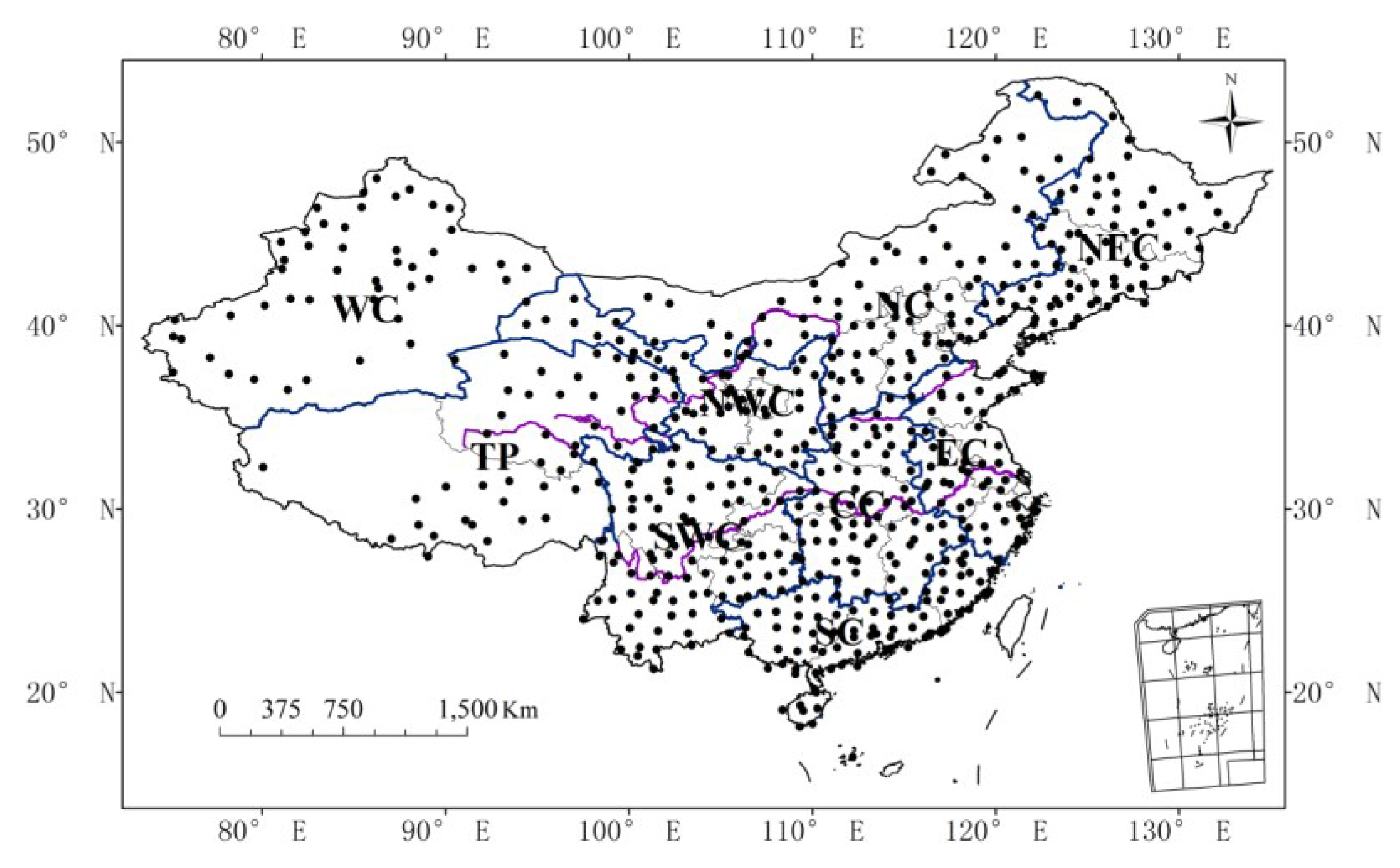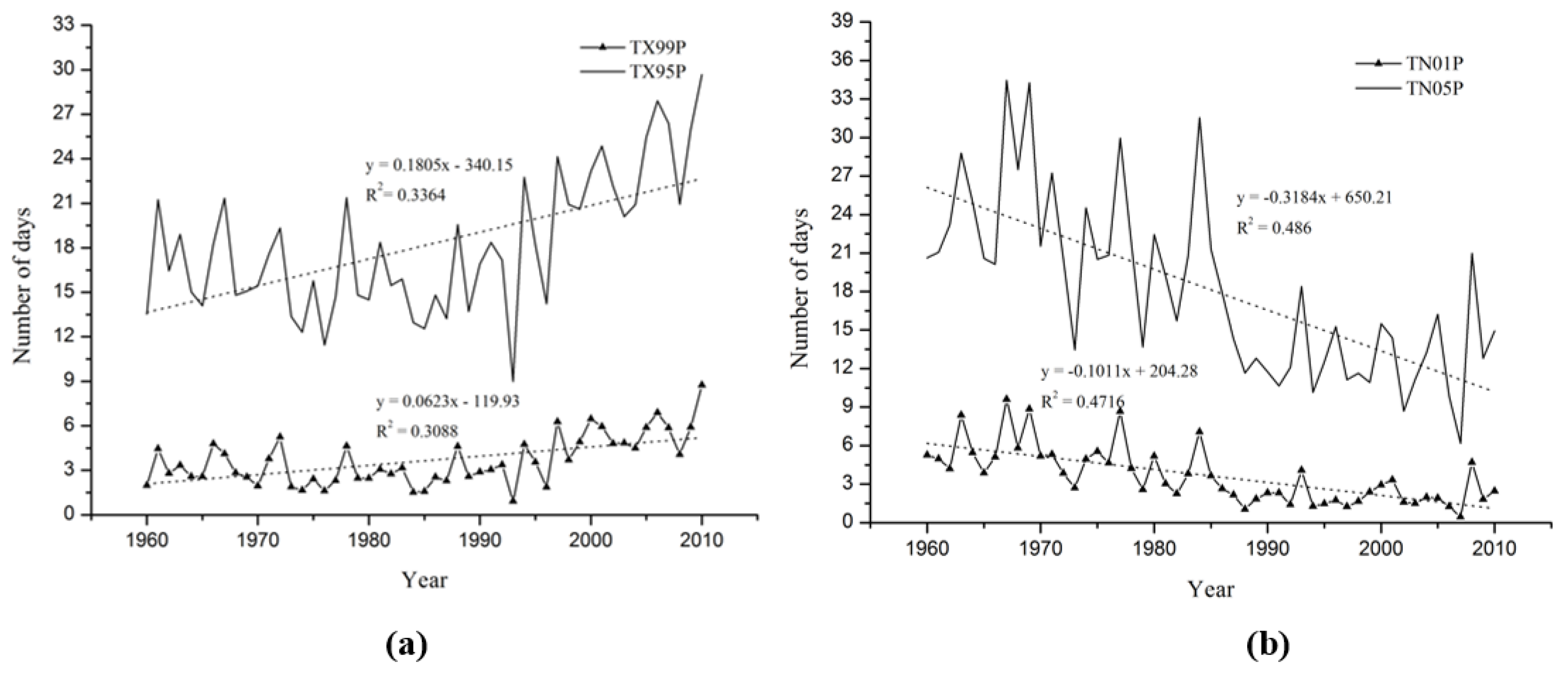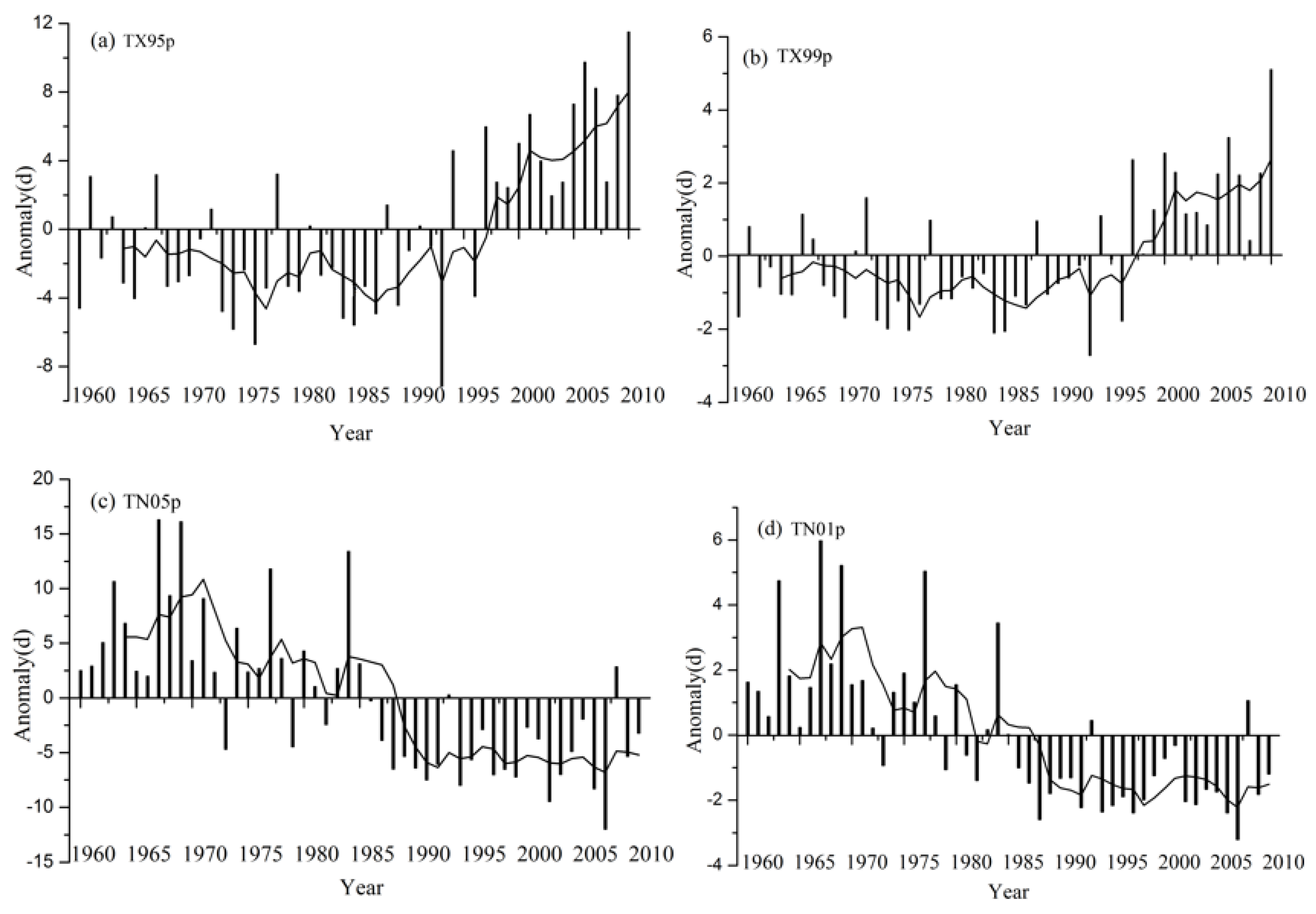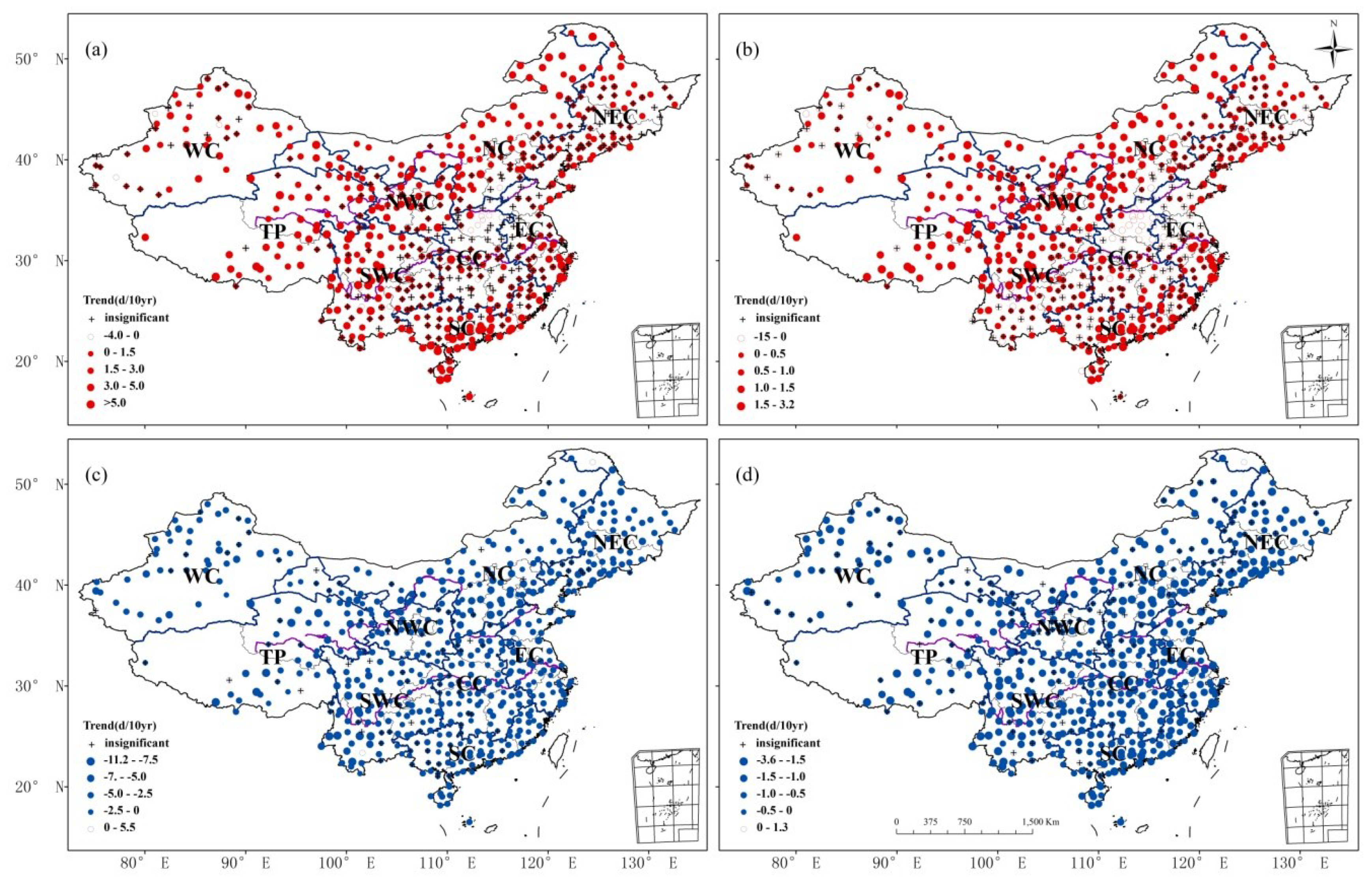Changing Trends and Abrupt Features of Extreme Temperature in Mainland China from 1960 to 2010
Abstract
:1. Introduction
2. Data and Methods
2.1. Data Source and Quality Control

2.2. Climate Zones in China
2.3. Extreme Temperature Indices
| Name | Index | Definition |
|---|---|---|
| Warm days | TX95p | Count of days where maximum temperature TX > 95th percentile |
| Hot days | TX99p | Count of days where maximum temperature TX > 99th percentile |
| Cold nights | TN05p | Count of days where minimum temperature TN < 5th percentile |
| Very Cold nights | TN01p | Count of days where minimum temperature TN < 1st percentile |
2.4. Trend Analysis, Significance Test, and Abrupt Change Detection
3. Results
3.1. Trends of Temperature Extremes


3.2. Spatial Variations of Trends in Extreme Temperature
| TX95p | TX99p | TN05p | TN01p | |||||
|---|---|---|---|---|---|---|---|---|
| Increase (%) | Decrease (%) | Increase (%) | Decrease (%) | Increase (%) | Decrease (%) | Increase (%) | Decrease (%) | |
| Mainland China | 50.42 | 3.38 | 58.21 | 4.74 | 0.85 | 83.76 | 1.18 | 76.48 |
| NEC | 37.50 | 0 | 43.06 | 0 | 1.39 | 86.11 | 1.39 | 37.5 |
| NC | 68.67 | 1.20 | 72.29 | 1.20 | 1.20 | 87.95 | 1.20 | 91.57 |
| SWC | 48.89 | 3.33 | 51.11 | 4.44 | 1.11 | 80.00 | 0 | 100 |
| TP | 40.43 | 0 | 44.68 | 0 | 2.13 | 39.36 | 0 | 18.09 |
| WC | 51.02 | 6.12 | 48.98 | 4.08 | 0 | 81.63 | 8.16 | 91.84 |
| SC | 65.33 | 4.00 | 58.67 | 2.67 | 0 | 82.67 | 0 | 100 |
| NWC | 66.67 | 1.96 | 74.51 | 0 | 0 | 80.39 | 0 | 80.39 |
| CC | 8.70 | 11.59 | 18.84 | 36.23 | 0 | 79.71 | 0 | 78.26 |
| EC | 32.73 | 1.82 | 32.73 | 7.27 | 0 | 96.36 | 1.82 | 49.09 |

3.3. Characteristics of Abrupt Changes in TX95p and TX99p Trends
| Year of Abrupt Change | Trends (day/10 year) Before and After Abrupt Changes | |||||
|---|---|---|---|---|---|---|
| TX95p | TX99p | TX95p | TX99p | |||
| Before | After | Before | After | |||
| NEC | 1981 | 2001 | 0.7 | 2.9 | 0.9 | 0.4 |
| NC | 1995 | 1996 | −0.9 | 1.8 | −0.4 | −1.0 |
| SWC | 2003 | 2001 | 0.45 | 12.1 | 0.1 | 5.3 |
| TP | 1992 | 1993 | 1.3 | 6.5 | 0.2 | 2.0 |
| WC | 1994 | 1996 | −0.05 | 0.74 | 0.04 | −0.28 |
| SC | 2000 | 1985 | 1.08 | 10.2 | −0.5 | 1.7 |
| NWC | 1995 | 1997 | −0.68 | 1.2 | 0.2 | 0.1 |
| CC | 1987 | 1987 | −4.7 | 4.1 | −1.7 | 1.1 |
| EC | 2000 | 2001 | −0.07 | 0.27 | −0.2 | −1.1 |
3.4. Characteristics of Abrupt Changes in TN05p and TN01p Trends
| Year of Abrupt Change | Trends (day/10 year) Before and After Abrupt Changes | |||||
|---|---|---|---|---|---|---|
| TN05p | TN01p | TN05p | TN01p | |||
| Before | After | Before | After | |||
| NEC | 1980 | 1976 | −0.9 | −1.7 | −2.5 | −1.2 |
| NC | 1980 | 1981 | −2.6 | −2.1 | −1.0 | −0.1 |
| SWC | 1985 | 1986 | −0.7 | −2.1 | −0.7 | −0.4 |
| TP | 2001 | 1986 | −3.4 | −2.7 | −1.7 | −1.0 |
| WC | 1980 | 1979 | 0.003 | −1.2 | 0.67 | −0.2 |
| SC | 1979 | 1985 | −2.6 | −2.3 | −0.5 | −0.2 |
| NWC | 1980 | 1981 | −1.8 | −1.1 | −0.4 | 0.2 |
| CC | 1984 | 1980 | 0.23 | −0.07 | −0.5 | −0.3 |
| EC | 1985 | 1983 | −0.59 | −0.05 | −1.0 | −0.6 |
4. Discussion
5. Conclusions
- (1)
- Warm days and hot days exhibited increasing trends over the last 51 years with a rapid increase after the mid-1980s. The cold and very cold nights exhibited decreasing trends in the last 51years with a rapid decrease from the 1960s to the 1990s.
- (2)
- The warm days (cold nights) and hot days (very cold nights) showed upward (downward) tendencies in most areas of China, but Central China and its surrounding areas showed decreasing tendencies in warm days and hot days.
- (3)
- The dates of observed abrupt changes in the trends of warm days and hot days were generally in the 1990s or 2000s, but the trends of cold nights and hot days changed in the early and mid-1980s. The increasing trends of warm days and hot days were greater after abrupt changes in most regions, which indicate a greater potential risk of heat waves in the future.
Acknowledgments
Author Contributions
Conflicts of Interest
References
- Intergovernmental Panel on Climate Change. Summary for policymakers. In Climate Change 2013: The Physical Science Basis. Contribution of Working Group to the Fifth Assessment Report of the Intergovernmental Panel on Climate Change; Stocker, T.F., Qin, D., Plattner, G.-K., Tignor, M., Allen, S.K., Boschung, J., Nauels, A., Xia, Y., Bex, V., Midgley, P.M., Eds.; Cambridge University Press: Cambridge, UK; New York, NY, USA, 2013. [Google Scholar]
- Alexander, L.V.; Zhang, X.; Peterson, T.C.; Caesar, J.; Gleason, B.; Klein Tank, A.M.G.; Haylock, M.; Collins, D.; Trewin, B.; Rahimzadeh, F.; et al. Global observed changes in daily climate extremes of temperature and precipitation. J. Geophys Res. Atmos. 2006, 111, D05109. [Google Scholar] [CrossRef]
- Intergovernmental Panel on Climate Change. Managing the Risks of Extreme Events and Disasters to Advance Climate Change Adaptation; Cambridge University Press: Cambridge, UK, 2012. [Google Scholar]
- Habeeb, D.; Vargo, J.; Stone, B., Jr. Rising heat wave trends in large US cities. Nat. Hazard. 2015, 76, 1651–1665. [Google Scholar] [CrossRef]
- McGregor, G.R.; Ferro, C.A.T.; Stephenson, D.B. Projected Changes in Extreme Weather and Climate Events in Europe Extreme Weather Events and Public Health Responses; Springer: New York, NY, USA, 2005; pp. 13–23. [Google Scholar]
- Asseng, S.; Foster, I.A.N.; Turner, N.C. The impact of temperature variability on wheat yields. Glob. Chang. Biol. 2011, 17, 997–1012. [Google Scholar] [CrossRef]
- Farooq, M.; Bramley, H.; Palta, J.A.; Siddique, K.H.M. Heat stress in wheat during reproductive and grain-filling phases. Crit. Rev. Plant Sci. 2011, 30, 491–507. [Google Scholar] [CrossRef]
- Lalić, B.; Eitzinger, J.; Thaler, S.; Vučetić, V.; Nejedlik, P.; Eckersten, H.; Jaćimović, G.; Nikolić-Djorić, E. Can agrometeorological indices of adverse weather conditions help to improve yield prediction by crop models? Atmosphere 2014, 5, 1020–1041. [Google Scholar] [CrossRef]
- Hadley, S.W.; Erickson, D.J.; Hernandez, J.L.; Broniak, C.T.; Blasing, T.J. Responses of energy use to climate change: A climate modeling study. Geophys. Res. Lett. 2006, 33, L17703. [Google Scholar] [CrossRef]
- Dematte, J.E.; O’Mara, K.; Buescher, J.; Whitney, C.G.; Forsythe, S.; McNamee, T.; Adiga, R.B.; Ndukwu, I.M. Near-fatal heat stroke during the 1995 heat wave in Chicago. Ann. Intern. Med. 1998, 129, 173–181. [Google Scholar] [CrossRef] [PubMed]
- Pantavou, K.; Theoharatos, G.; Mavrakis, A.; Santamouris, M. Evaluating thermal comfort conditions and health responses during an extremely hot summer in Athens. Build. Environ. 2011, 46, 339–344. [Google Scholar] [CrossRef]
- Nitschke, M.; Hansen, A.; Bi, P.; Pisaniello, D.; Newbury, J.; Kitson, A.; Tucker, G.; Avery, J.; Dal Grande, E. Risk factors, health effects and behaviour in older people during extreme heat: A survey in south Australia. Int. J. Environ. Res. Public Health 2013, 10, 6721–6733. [Google Scholar] [CrossRef] [PubMed]
- Klein Tank, A.M.G.; Zwiers, F.W.; Zhang, X. Guidelines on Analysis of Extremes in a Changing Climate in Support of Informed Decisions for Adaptation; World Meteorological Organisation (WMO): Geneva, Switzerland, 2009.
- Chen, Q.; Li, Z.; Fan, G.; Zhu, K.; Zhang, W.; Zhu, H. Indications of stratospheric anomalies in the freezing rain and snow disaster in south China, 2008. Sci. China Earth Sci. 2011, 54, 1248–1256. [Google Scholar] [CrossRef]
- Bonsal, B.R.; Zhang, X.; Vincent, L.A.; Hogg, W.D. Characteristics of daily and extreme temperatures over Canada. J. Clim. 2001, 14, 1959–1976. [Google Scholar] [CrossRef]
- DeGaetano, A.T.; Allen, R.J. Trends in twentieth-century temperature extremes across the United States. J. Clim. 2002, 15, 3188–3205. [Google Scholar] [CrossRef]
- Klein Tank, A.M.G.; Können, G.P. Trends in indices of daily temperature and precipitation extremes in Europe, 1946–99. J. Clim. 2003, 16, 3665–3680. [Google Scholar] [CrossRef]
- Zhou, Y.; Ren, G. Change in extreme temperature event frequency over mainland China, 1961–2008. Clim. Res. 2011, 50, 125–139. [Google Scholar] [CrossRef]
- Kothawale, D.R.; Revadekar, J.V.; Kumar, K.R. Recent trends in pre-monsoon daily temperature extremes over India. J. Earth Syst. Sci. 2010, 119, 51–65. [Google Scholar] [CrossRef]
- Aguilar, E.; Peterson, T.C.; Obando, P.R.; Frutos, R.; Retana, J.A.; Solera, M.; Soley, J.; García, I.G.; Araujo, R.M.; Santos, A.R.; et al. Changes in precipitation and temperature extremes in central America and northern south America, 1961–2003. J. Geophys. Res. 2005, 110, D23107. [Google Scholar] [CrossRef]
- Rusticucci, M. Observed and simulated variability of extreme temperature events over south America. Atmos. Res. 2012, 106, 1–17. [Google Scholar] [CrossRef]
- Nemec, J.; Gruber, C.; Chimani, B.; Auer, I. Trends in extreme temperature indices in Austria based on a new homogenised dataset. Int. J. Climatol. 2013, 33, 1538–1550. [Google Scholar] [CrossRef]
- You, Q.; Ren, G.; Fraedrich, K.; Kang, S.; Ren, Y.; Wang, P. Winter temperature extremes in china and their possible causes. Int. J. Climatol. 2013, 33, 1444–1455. [Google Scholar] [CrossRef]
- Liang, K.; Bai, P.; Li, J.; Liu, C. Variability of temperature extremes in the yellow river basin during 1961–2011. Quat. Int. 2014, 336, 52–64. [Google Scholar] [CrossRef]
- Wang, B.; Zhang, M.; Wei, J.; Wang, S.; Li, S.; Ma, Q.; Li, X.; Pan, S. Changes in extreme events of temperature and precipitation over Xinjiang, northwest China, during 1960–2009. Quat. Int. 2013, 298, 141–151. [Google Scholar] [CrossRef]
- Yu, Z.; Li, X. Recent trends in daily temperature extremes over northeastern China (1960–2011). Quat. Int. 2015, 380–381, 35–48. [Google Scholar] [CrossRef]
- Wood, E.M.; Pidgeon, A.M. Extreme variations in spring temperature affect ecosystem regulating services provided by birds during migration. Ecosphere 2015, 6, art216. [Google Scholar] [CrossRef]
- Zhang, Y.; Voigt, M.; Liu, H. Contrasting responses of terrestrial ecosystem production to hot temperature extreme regimes between grassland and forest. Biogeosciences 2015, 11, 5997–6017. [Google Scholar] [CrossRef]
- Jeffree, E.P. Temperature-ranges and distributions of some vascular plants. Nature 1955, 484, 703–704. [Google Scholar] [CrossRef]
- Criddle, R.S.; Hopkin, M.S.; McArthur, E.D.; Hansen, L.D. Plant distribution and the temperature coefficient of metabolism. Plant Cell Environ. 1994, 17, 233–243. [Google Scholar] [CrossRef]
- Matyasovszky, I.; Ljungqvist, F. Abrupt temperature changes during the last 1500 years. Theor. Appl. Climatol. 2013, 112, 215–225. [Google Scholar] [CrossRef]
- Temnerud, J.; Weyhenmeyer, G.A. Abrupt changes in air temperature and precipitation: Do they matter for water chemistry. Glob. Biogeochem. Cycles 2008, 2008, 135–157. [Google Scholar] [CrossRef]
- Yonetani, T.; Mccabe, G.J. Abrupt changes in regional temperature in the conterminous United States, 1895–1989. Clim. Res. 1994, 4, 13–23. [Google Scholar] [CrossRef]
- Chen, Y.; Deng, H.; Li, B.; Li, Z.; Xu, C. Abrupt change of temperature and precipitation extremes in the arid region of northwest China. Quat. Int. 2014, 336, 35–43. [Google Scholar] [CrossRef]
- Liu, L.; Xu, Z.-X.; Huang, J.-X. Spatio-temporal variation and abrupt changes for major climate variables in the Taihu Basin, China. Stoch. Environ. Res. Risk Assess. 2012, 26, 777–791. [Google Scholar] [CrossRef]
- Li, Q.; Zhang, H.; Liu, X.; Chen, J.; Li, W.; Jones, P. A mainland china homogenized historical temperature dataset of 1951–2004. Bull. Am. Meteorol. Soc. 2009, 90, 1062–1065. [Google Scholar] [CrossRef]
- Xu, W.; Li, Q.; Wang, X.L.; Yang, S.; Cao, L.; Feng, Y. Homogenization of Chinese daily surface air temperatures and analysis of trends in the extreme temperature inices. J. Geophys. Res. Atmos. 2013, 118, 9708–9720. [Google Scholar] [CrossRef]
- Zhang, X.; Yan, X. Temporal change of climate zones in china in the context of climate warming. Theor. Appl. Climatol. 2013, 115, 167–175. [Google Scholar] [CrossRef]
- Zhang, X.; Hegerl, G.; Zwiers, F.W.; Kenyon, J. Avoiding inhomogeneity in percentile-based indices of temperature extremes. J. Clim. 2005, 18, 1641–1651. [Google Scholar] [CrossRef]
- Frich, P.; Alexander, L.V.; Della-Marta, P.; Gleason, B.; Haylock, M.; Klein Tank, A.M.G.; Peterson, T. Observed coherent changes in climatic extremes during the second half of the twentieth century. Clim. Res. 2002, 19, 193–212. [Google Scholar] [CrossRef]
- Wei, F. Modern Diagnosis and Prediction of Climate Statistics, 2nd ed.; Chinse Meteorological Press: Beijing, China, 2007. [Google Scholar]
- Kendall, M.G. Rank Correlation Methods, 4th ed.; Charles Griffin: London, UK, 1975. [Google Scholar]
- Mann, H.B. Non-parametric test against trend. Econometrica 1945, 13, 245–259. [Google Scholar] [CrossRef]
- Gocic, M.; Trajkovic, S. Analysis of changes in meteorological variables using mann-kendall and Sen’s slope estimator statistical tests in Serbia. Glob. Planet. Chang. 2013, 100, 172–182. [Google Scholar] [CrossRef]
- Kadioğlu, M. Trends in surface air temperature data over Turkey. Int. J. Climatol. 1997, 17, 511–520. [Google Scholar] [CrossRef]
- Pingale, S.M.; Khare, D.; Jat, M.K.; Adamowski, J. Spatial and temporal trends of mean and extreme rainfall and temperature for the 33 urban centers of the arid and semi-arid state of Rajasthan, India. Atmos. Res. 2014, 138, 73–90. [Google Scholar] [CrossRef]
- Sayemuzzaman, M.; Jha, M.K. Seasonal and annual precipitation time series trend analysis in north Carolina, United States. Atmos. Res. 2014, 137, 183–194. [Google Scholar] [CrossRef]
- Yue, S.; Pilon, P.; Cavadias, G. Power of the Mann–Kendall and Spearman’s rho tests for detecting monotonic trends in hydrological series. J. Hydrol. 2002, 259, 254–271. [Google Scholar] [CrossRef]
- Kisi, O.; Ay, M. Comparison of Mann-Kendall and innovative trend method for water quality parameters of the Kizilirmak river. J. Hydrol. 2014, 513, 362–375. [Google Scholar] [CrossRef]
- Easterling, D.R.; Horton, B.; Jones, P.D.; Peterson, T.C.; Karl, T.R.; Parker, D.E.; Salinger, M.J.; Razuvayev, V.; Plummer, N.; Jamason, P.; et al. Maximum and minimum temperature trends for the globe. Science 1997, 277, 364–367. [Google Scholar] [CrossRef]
- Karl, T.R.; Knight, R.W.; Gallo, K.P.; Peterson, T.C.; Jones, P.D.; Kukla, G.; Plummer, N.; Razuvayev, V.; Lindseay, J.; Charlson, R.J. A new perspective on recent global warming: Asymmetric trends of daily maximum and minimum temperature. Bull. Am. Meteorol. Soc. 1993, 74, 1007–1023. [Google Scholar] [CrossRef]
- Vose, R.S.; Easterling, D.R.; Gleason, B. Maximum and minimum temperature trends for the globe: An update through 2004. Geophys. Res. Lett. 2005, 32, L23822. [Google Scholar] [CrossRef]
- Li, Z.; Liu, W.; Zheng, F. Trends of extreme temperature events in Jinghe watershed during 1965–2005. Sci. Geogr. Sin. 2010, 30, 469–474. [Google Scholar]
- Zhai, P.; Pan, X. Change in extreme temperature and precipitation over northern China during the second half of the 20th century. Acta Geogr. Sin. 2003, 58, 1–8. [Google Scholar]
- Shi, J.; Cui, L. Characteristics of high impact weather and meteorological disaster in Shanghai, China. Nat. Hazards 2012, 60, 951–969. [Google Scholar] [CrossRef]
- Ding, Y.; Wang, Z.; Sun, Y. Inter-decadal variation of the summer precipitation in east China and its association with decreasing asian summer monsoon. Part I: Observed evidences. Int. J. Climatol. 2008, 28, 1139–1161. [Google Scholar] [CrossRef]
- Huang, R.; Chen, J.; Wang, L.; Lin, Z. Characteristics, processes, and causes of the spatio-temporal variabilities of the east Asian monsoon system. Adv. Atmos. Sci. 2012, 29, 910–942. [Google Scholar] [CrossRef]
- Zhang, R. Changes in east Asian summer monsoon and summer rainfall over eastern China during recent decades. Sci. Bull. 2015, 60, 1222–1224. [Google Scholar] [CrossRef]
- Wang, L.; Chen, W. How well do existing indices measure the strength of the east Asian winter monsoon? Adv. Atmos. Sci. 2010, 27, 855–870. [Google Scholar] [CrossRef]
- Wang, L.; Huang, R.; Gu, L.; Chen, W.; Kang, L. Interdecadal variations of the east Asian winter monsoon and their association with quasi-stationary planetary wave activity. J. Clim. 2009, 22, 4860–4872. [Google Scholar] [CrossRef]
- Qi, L.; Wang, Y. Changes in the observed trends in extreme temperatures over China around 1990. J. Clim. 2012, 25, 5208–5222. [Google Scholar] [CrossRef]
- Li, J.; Dong, W.; Yan, Z. Changes of climate extremes of temperature and precipitation in summer in eastern China associated with changes in atmospheric circulation in east Asia during 1960–2008. Chin. Sci. Bull. 2012, 57, 1856–1861. [Google Scholar] [CrossRef]
- Ding, T.; Qian, W.; Yan, Z. Changes in hot days and heat waves in china during 1961–2007. Int. J. Climatol. 2010, 30, 1452–1462. [Google Scholar] [CrossRef]
- Yao, Y.; Luo, Y.; Huang, J.-B. Evaluation and projection of temperature extremes over China based on CMIP5 model. Adv. Clim. Chang. Res. 2012, 3, 179–185. [Google Scholar] [CrossRef]
- Fang, S.B.; Cammarano, D.; Zhou, G.S.; Tan, K.Y.; Ren, S.X. Effects of increased day and night temperature with supplemental infrared heating on winter wheat growth in north China. Eur. J. Agron. 2015, 64, 67–77. [Google Scholar] [CrossRef]
- Fang, S.B.; Su, H.; Liu, W.; Tan, K.; Ren, S. Infrared warming reduced winter wheat yields and some physiological parameters, which were mitigated by irrigation and worsened by delayed sowing. PLoS ONE 2013, 8, E67518. [Google Scholar]
- Richardson, A.D.; Keenan, T.F.; Migliavacca, M.; Ryu, Y.; Sonnentag, O.; Toomey, M. Climate change, phenology, and phenological control of vegetation feedbacks to the climate system. Agric. For. Meteorol. 2013, 169, 156–173. [Google Scholar] [CrossRef]
© 2016 by the authors; licensee MDPI, Basel, Switzerland. This article is an open access article distributed under the terms and conditions of the Creative Commons by Attribution (CC-BY) license (http://creativecommons.org/licenses/by/4.0/).
Share and Cite
Fang, S.; Qi, Y.; Han, G.; Li, Q.; Zhou, G. Changing Trends and Abrupt Features of Extreme Temperature in Mainland China from 1960 to 2010. Atmosphere 2016, 7, 22. https://doi.org/10.3390/atmos7020022
Fang S, Qi Y, Han G, Li Q, Zhou G. Changing Trends and Abrupt Features of Extreme Temperature in Mainland China from 1960 to 2010. Atmosphere. 2016; 7(2):22. https://doi.org/10.3390/atmos7020022
Chicago/Turabian StyleFang, Shibo, Yue Qi, Guojun Han, Qingxiang Li, and Guangsheng Zhou. 2016. "Changing Trends and Abrupt Features of Extreme Temperature in Mainland China from 1960 to 2010" Atmosphere 7, no. 2: 22. https://doi.org/10.3390/atmos7020022
APA StyleFang, S., Qi, Y., Han, G., Li, Q., & Zhou, G. (2016). Changing Trends and Abrupt Features of Extreme Temperature in Mainland China from 1960 to 2010. Atmosphere, 7(2), 22. https://doi.org/10.3390/atmos7020022






